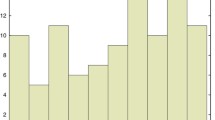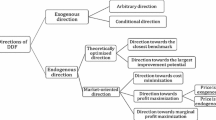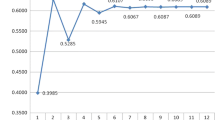Abstract
As one of the most useful performance and productivity evaluation tools, the directional distance function (DDF) has received substantial attention and research. One of the key concerns to address in DDF measurement is selecting the direction along which to measure the distance from an inefficient decision making unit (DMU) to the production frontier. The least distance approach helps the inefficient DMUs find their own most preferred directions that maximize their own efficiency scores with least effort, but some DMUs may not accept the results because of the inconsistent evaluation basis. To overcome this limitation, we propose a peer-evaluation mode to evaluate the performance of the DMUs. We give a cross-directional evaluation approach and further provide a cross-bargaining game approach. In the cross-directional evaluation approach, each inefficient DMU is evaluated using both its own preferred projection direction and the other DMUs’ most preferred projection directions. However, the resulting average cross-directional efficiencies are not Pareto-optimal, so we develop a cross-bargaining game approach to improve the cross-directional efficiency approach even further. In the cross-bargaining game, each pair of inefficient DMUs is treated as two players who will obtain a common projection direction by bargaining with each other. The use of cross-bargaining negotiated projection directions and the Pareto-optimality of the DMUs’ final average cross-bargaining-directional efficiencies make the evaluation results more acceptable to all inefficient DMUs. Finally, an empirical example of 28 international airlines is applied to illustrate the practicality and superiority of our cross-bargaining game approach.

Similar content being viewed by others
References
Adler N, Volta N (2016) Accounting for externalities and disposability: a directional economic environmental distance function. Eur J Oper Res 250(1):314–327
Amirteimoori A, Kordrostami S (2010) A Euclidean distance-based measure of efficiency in data envelopment analysis. Optimization 59(7):985–996
Ando K, Kai A, Maeda Y, Sekitani K (2012) Least distance based inefficiency measures on the Pareto-efficient frontier in DEA. J Oper Res Soc Jpn 55(1):73–91
Aparicio J, Pastor JT (2013) A well-defined efficiency measure for dealing with closest targets in DEA. Appl Math Comput 219(17):9142–9154
Aparicio J, Pastor JT (2014a) Closest targets and strong monotonicity on the strongly efficient frontier in DEA. Omega 44:51–57
Aparicio J, Pastor JT (2014b) On how to properly calculate the Euclidean distance-based measure in DEA. Optimization 63(3):421–432
Aparicio J, Ruiz JL, Sirvent I (2007) Closest targets and minimum distance to the Pareto-efficient frontier in DEA. J Product Anal 28(3):209–218
Aparicio J, Pastor JT, Vidal F (2016) The directional distance function and the translation invariance property. Omega 58:1–3
Aparicio J, Cordero JM, Pastor JT (2017) The determination of the least distance to the strongly efficient frontier in data envelopment analysis oriented models: modelling and computational aspects. Omega 71:1–10
Baek C, Lee JD (2009) The relevance of DEA benchmarking information and the least-distance measure. Math Comput Model 49(1):265–275
Bal H, Örkcü HH, Çelebioğlu S (2010) Improving the discrimination power and weights dispersion in the data envelopment analysis. Comput Oper Res 37(1):99–107
Banker RD, Charnes A, Cooper WW (1984) Some models for estimating technical and scale inefficiencies in data envelopment analysis. Manag Sci 30(9):1078–1092
Bellenger MJ, Herlihy AT (2009) An economic approach to environmental indices. Ecol Econ 68(8):2216–2223
Briec W (1999) Hölder distance function and measurement of technical efficiency. J Product Anal 11(2):111–131
Briec W, Leleu H (2003) Dual representations of non-parametric technologies and measurement of technical efficiency. J Product Anal 20(1):71–96
Briec W, Lemaire B (1999) Technical efficiency and distance to a reverse convex set. Eur J Oper Res 114(1):178–187
Briec W, Lesourd JB (1999) Metric distance function and profit: some duality results. J Optim Theory Appl 101(1):15–33
Chambers RG, Chung Y, Färe R (1996a) Benefit and distance functions. J Econ Theory 70(2):407–419
Chambers RG, Fāure R, Grosskopf S (1996b) Productivity growth in APEC countries. Pac Econ Rev 1(3):181–190
Chambers RG, Chung Y, Färe R (1998) Profit, directional distance functions, and Nerlovian efficiency. J Optim Theory Appl 98(2):351–364
Charnes A, Cooper WW (1962) Programming with linear fractional functionals. Naval Res Logist (NRL) 9(3–4):181–186
Charnes A, Cooper WW, Rhodes E (1978) Measuring the efficiency of decision making units. Eur J Oper Res 2(6):429–444
Chu J, Wu J, Chu C, Zhang T (2019) DEA-based fixed cost allocation in two-stage systems: leader-follower and satisfaction degree bargaining game approaches. Omega. https://doi.org/10.1016/j.omega.2019.03.012
Coelli T, Grifell-Tatje E, Perelman S (2002) Capacity utilisation and profitability: a decomposition of short-run profit efficiency. Int J Prod Econ 79(3):261–278
Dervaux B, Leleu H, Minvielle E, Valdmanis V, Aegerter P, Guidet B (2009) Performance of French intensive care units: a directional distance function approach at the patient level. Int J Prod Econ 120(2):585–594
Färe R, Grosskopf S (2010) Directional distance functions and slacks-based measures of efficiency. Eur J Oper Res 200(1):320–322
Färe R, Grosskopf S, Weber WL (2006) Shadow prices and pollution costs in US agriculture. Ecol Econ 56(1):89–103
Färe R, Grosskopf S, Whittaker G (2013) Directional output distance functions: endogenous directions based on exogenous normalization constraints. J Product Anal 40(3):267–269
Frei FX, Harker PT (1999) Projections onto efficient frontiers: theoretical and computational extensions to DEA. J Product Anal 11(3):275–300
Fukuyama H, Maeda Y, Sekitani K, Shi J (2014a) Input–output substitutability and strongly monotonic p-norm least distance DEA measures. Eur J Oper Res 237(3):997–1007
Fukuyama H, Masaki H, Sekitani K, Shi J (2014b) Distance optimization approach to ratio-form efficiency measures in data envelopment analysis. J Prod Anal 42(2):175–186
Fukuyama H, Hougaard JL, Sekitani K, Shi J (2016) Efficiency measurement with a non-convex free disposal hull technology. J Oper Res Soc 67(1):9–19
González E, Álvarez A (2001) From efficiency measurement to efficiency improvement: the choice of a relevant benchmark. Eur J Oper Res 133(3):512–520
Granderson G, Prior D (2013) Environmental externalities and regulation constrained cost productivity growth in the US electric utility industry. J Prod Anal 39(3):243–257
Halkos GE, Tzeremes NG (2013) A conditional directional distance function approach for measuring regional environmental efficiency: evidence from UK regions. Eur J Oper Res 227(1):182–189
Hampf B, Krüger JJ (2014a) Optimal directions for directional distance functions: an exploration of potential reductions of greenhouse gases. Am J Agric Econ 97(3):920–938
Hampf B, Krüger JJ (2014b) Technical efficiency of automobiles—a nonparametric approach incorporating carbon dioxide emissions. Transp Res Part D Transp Environ 33:47–62
Jahanshahloo GR, Lotfi FH, Rezai HZ, Balf FR (2007) Finding strong defining hyperplanes of production possibility set. Eur J Oper Res 177(1):42–54
Jiang JL, Chew EP, Lee LH, Sun Z (2012) DEA based on strongly efficient and inefficient frontiers and its application on port efficiency measurement. OR Spectr 34(4):943–969
Kao C, Hung HT (2005) Data envelopment analysis with common weights: the compromise solution approach. J Oper Res Soc 56(10):1196–1203
Lee CY (2014) Meta-data envelopment analysis: finding a direction towards marginal profit maximization. Eur J Oper Res 237(1):207–216
Lee CY (2016) Nash-profit efficiency: a measure of changes in market structures. Eur J Oper Res 255(2):659–663
Lee CY (2018) Mixed-strategy Nash equilibrium in data envelopment analysis. Eur J Oper Res 266(3):1013–1024
Lee CY, Johnson AL (2015) Measuring efficiency in imperfectly competitive markets: an example of rational inefficiency. J Optim Theory Appl 164(2):702–722
Lee JD, Park JB, Kim TY (2002) Estimation of the shadow prices of pollutants with production/environment inefficiency taken into account: a nonparametric directional distance function approach. J Environ Manag 64(4):365–375
Lozano S, Villa G (2005) Determining a sequence of targets in DEA. J Oper Res Soc 56(12):1439–1447
Luenberger DG (1992) Benefit functions and duality. J Math Econ 21(5):461–481
Nash JF Jr (1950) The bargaining problem. Econom J Econom Soc 5:155–162
Njuki E, Bravo-Ureta BE (2015) The economic costs of environmental regulation in US dairy farming: a directional distance function approach. Am J Agric Econ 97(4):1087–1106
Oum TH, Pathomsiri S, Yoshida Y (2013) Limitations of DEA-based approach and alternative methods in the measurement and comparison of social efficiency across firms in different transport modes: an empirical study in Japan. Transp Res Part E Logist Transp Rev 57:16–26
Pastor JT, Aparicio J (2010) The relevance of DEA benchmarking information and the least-distance measure: comment. Math Comput Model 52(1–2):397–399
Peyrache A, Daraio C (2012) Empirical tools to assess the sensitivity of directional distance functions to direction selection. Appl Econ 44(8):933–943
Portela MS, Thanassoulis E, Simpson G (2004) Negative data in DEA: a directional distance approach applied to bank branches. J Oper Res Soc 55(10):1111–1121
Ray SC (2004) Data envelopment analysis: theory and techniques for economics and operations research. Cambridge University Press, Cambridge
Ray SC (2008) The directional distance function and measurement of super-efficiency: an application to airlines data. J Oper Res Soc 59(6):788–797
Ray SC, Mukherjee K (2000) Decomposition of cost competitiveness in US manufacturing: some state-by-state comparisons. Indian Econ Rev 35:133–153
Ruiz JL (2013) Cross-efficiency evaluation with directional distance functions. Eur J Oper Res 228(1):181–189
Ruiz JL, Sirvent I (2016) Common benchmarking and ranking of units with DEA. Omega 65:1–9
Simar L, Vanhems A, Wilson PW (2012) Statistical inference for DEA estimators of directional distances. Eur J Oper Res 220(3):853–864
Sun J, Wu J, Guo D (2013) Performance ranking of units considering ideal and anti-ideal DMU with common weights. Appl Math Model 37(9):6301–6310
Wang YM, Chin KS, Leung JPF (2009) A note on the application of the data envelopment analytic hierarchy process for supplier selection. Int J Prod Res 47(11):3121–3138
Wang K, Wei YM, Zhang X (2013) Energy and emissions efficiency patterns of Chinese regions: a multi-directional efficiency analysis. Appl Energy 104:105–116
Wang K, Xian Y, Lee CY, Wei YM, Huang Z (2017) On selecting directions for directional distance functions in a non-parametric framework: a review. Ann Oper Res. https://doi.org/10.1007/s10479-017-2423-5
Wu J, Liang L, Yang F, Yan H (2009) Bargaining game model in the evaluation of decision making units. Expert Syst Appl 36(3):4357–4362
Wu J, Chu J, Zhu Q, Li Y, Liang L (2016a) Determining common weights in data envelopment analysis based on the satisfaction degree. J Oper Res Soc 67(12):1446–1458
Wu J, Chu J, Sun J, Zhu Q (2016b) DEA cross-efficiency evaluation based on Pareto improvement. Eur J Oper Res 248(2):571–579
Yang F, Wei F, Li Y, Huang Y, Chen Y (2018) Expected efficiency based on directional distance function in data envelopment analysis. Comput Ind Eng 125:33–45
Yin P, Chu J, Wu J, Ding J, Yang M, Wang Y (2019) A DEA-based two-stage network approach for hotel performance analysis: an internal cooperation perspective. Omega. https://doi.org/10.1016/j.omega.2019.02.004
Zhang N, Choi Y (2014) A note on the evolution of directional distance function and its development in energy and environmental studies 1997–2013. Renew Sustain Energy Rev 33:50–59
Zhu Q, Wu J, Ji X, Li F (2018) A simple MILP to determine closest targets in non-oriented DEA model satisfying strong monotonicity. Omega 79:1–8
Zofio JL, Pastor JT, Aparicio J (2013) The directional profit efficiency measure: on why profit inefficiency is either technical or allocative. J Prod Anal 40(3):257–266
Acknowledgements
The authors are grateful to the editor, associate editor, and four anonymous reviewers for their helpful comments and suggestions. This research is supported by National Natural Science Foundation of China (Nos. 71631006, 71771071, 71601173), and the Fundamental Research Funds for the Central Universities (WK2040160028).
Author information
Authors and Affiliations
Corresponding author
Additional information
Publisher’s Note
Springer Nature remains neutral with regard to jurisdictional claims in published maps and institutional affiliations.
Rights and permissions
About this article
Cite this article
Wei, F., Chu, J., Song, J. et al. A cross-bargaining game approach for direction selection in the directional distance function. OR Spectrum 41, 787–807 (2019). https://doi.org/10.1007/s00291-019-00557-w
Received:
Accepted:
Published:
Issue Date:
DOI: https://doi.org/10.1007/s00291-019-00557-w




